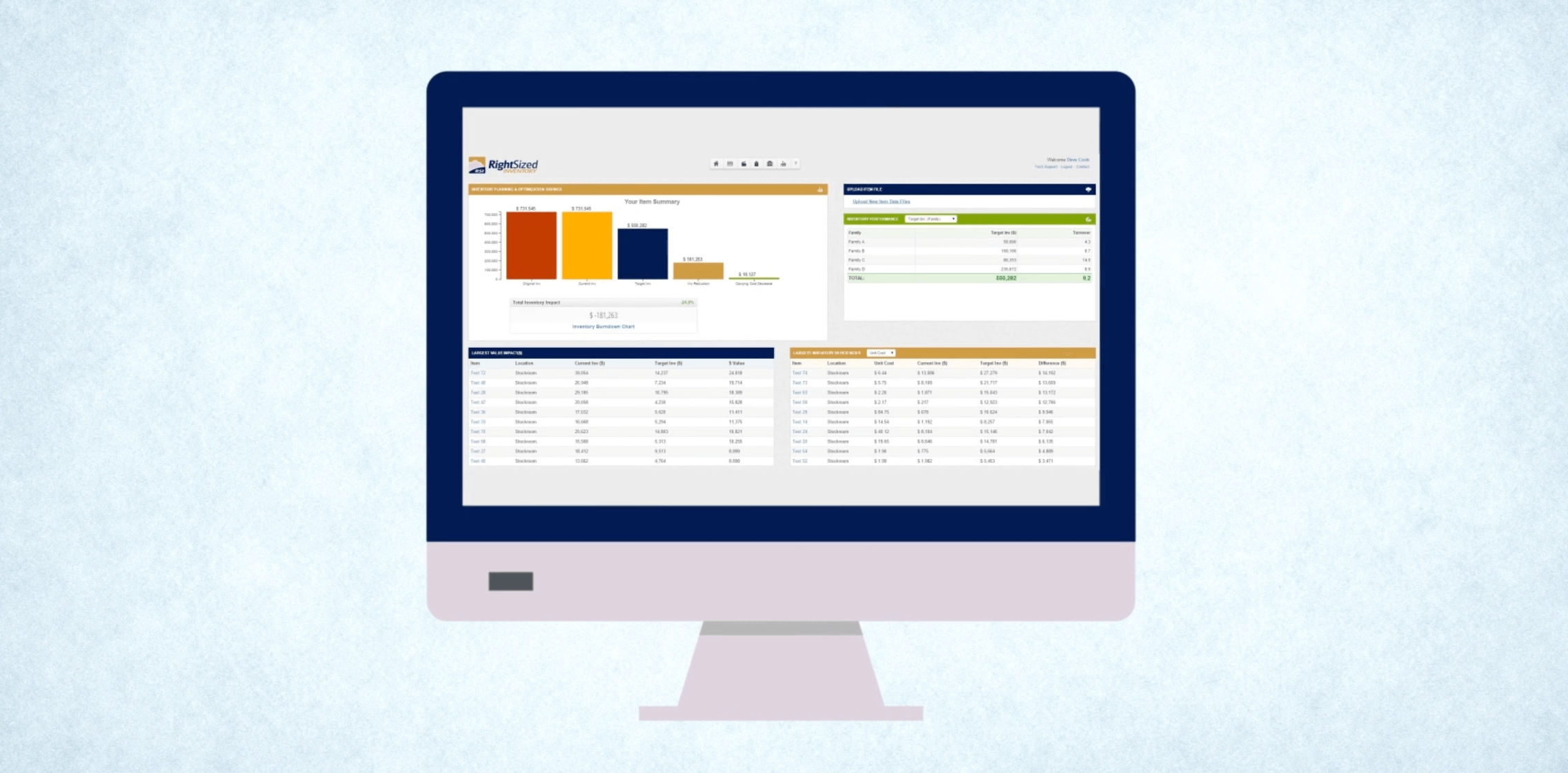How to Disrupt a Market with an Inventory-Predictive-Analysis Solution - Startup Stories with David McPhetrige

Anton Oparienko (COO, Upsilon): Today, I'm speaking to David McPhetrige, a business partner at Right Sized Inventory. Could you share a few words about your background and your way to the current position?
David McPhetrige (Right Sized Inventory business partner): Well, I have been involved in the supply chain world ever since I got my first job. One way or another, I've dealt with MRP and ERP systems, and cost accounting for reporting on inventory. I've always been very interested in how to optimize that field. It is well-known that inventory can perform well, but the service-level can lag and vice versa. So, I started wondering how to figure out the optimal inventory level for every item in a supply chain. I started researching and found different formulas to calculate that indicator. But these didn't work out as they weren't flexible and didn't handle the issue of intermittency very well. For example, there can be a lot of items in inventory with intermittent demand.

So, I started trying to refine and tweak the formulas. I came up with my own one but it wouldn't work either. Finally, I started putting together a Monte Carlo simulation of an inventory supply chain. So, I came up with the defining factors for any stocked inventory item. Depending on how you count the factors, there are about 10 or 12 of them. With those defining factors, I built a simulation that worked as a prototype. Then I coded it so that it could run in a program. Over the years, I ended up with a functional, robust, and market-ready solution. That was my way to becoming a business partner with Right Sized Inventory. Now my software is used in our software-as-a-service online solution.
Anton: How did you meet your business partner?
David: My business partner is Dave Cook. I hadn't known him before we started our business. We only had a mutual workmate who introduced us to each other. Dave had a great background in supply chain as well but on the side of sales and marketing. Together, we came up with something that was technically correct and viable at the same time. We were able to turn our solution into something that had marketing and selling value.
Anton: Did it take a long time to convince him that the solution is credible?
David: By coincidence, Dave wanted to start a business that would deal with inventory optimization. But he was looking for the best way to implement that idea. He wanted to provide an inventory optimization service and use some version of an optimization formula for every item. When I contacted him, I had my probabilistic simulation model ready. It turned out to be just exactly what he was looking for. So, we made a connection right away and started working on putting together a business and software-as-a-service after we met.
Anton: Could you tell me about the hardest parts of your way?
David: I think the hardest part was getting initial clients because inventory optimization and predictive analytics are quite specialized topics. Putting our website out there alone wasn't working. We started using lead generation which is honestly a sheer numbers game. It could take thousands of emails or business phone system calls before a live opportunity could arise.
The hard part beyond that was to explain to a prospective client why our software is better and how it works. Initially, we pitched it to some clients from my business partner's former connections. Dave was able to validate the potential of our software and the value of complex simulations.
That's how we started to get first clients. With them, we were able to get testimonials, show real results, and pitch them to prospective clients.
Anton: And what were the best achievements with Right Sized Inventory?
David: One of them was the timing of the Right Sized Inventory service. When I started with developing it, I wasn't thinking about it in terms of predictive analytics. I didn't even realize it was a sort of predictive analytics at the time! I was trying to get a model that would work correctly and optimize the item's inventory level.
Back then, when finishing up the development of the actual software program, I noticed that Gartner was providing much research and publications for the supply chain world. They were starting to state that predictive analytics could be the future of the supply chain world. I realized that my model also belonged to that sphere. When my business partner and I started offering our solution as software-as-a-service, it happened at the right time.
Another good achievement was that we were able to hit the market with our offering. It was easy to use and learn and didn't involve complicated implementation or deployment. Actually, other businesses contacted us because they were aware of the impact of predictive analytics on inventory optimization. They would Google it, and the Right Sized inventory solution would come up as a search result. I believe it was an easy win.
Anton: What are you working on right now? Where is predictive analytics going in terms of the product and its features?
David: Just to mention, there are other predictive analytics methods that Right Sized Inventory enhances. For instance, there are demand-sensing forecasting, inventory network design, and modeling.

We match up with all of those touchpoints using a forecasting solution. There is a random variation in any item's supply chain. And random variation can't be forecast because you don't know the timing of it. Forecasting is all about timing. So, forecasting captures all of the other forms of variation like trend and seasonality or special causes.
So, we're like a worthy end of the sentence for a forecasting system. For instance, a client who has demand-sensing forecasting and uses our service can address all forms of variations. As we continue to refine our service, we're working on the ability to identify trends and detect things like seasonality.
We don't want to include that feature in our solution yet. Our focus is on other things. We want to make our solution easy to use for any user in the first place.
Anton: What do you think about the current state of the supply chain world? What's happening right now and in which direction is it moving? Will it continue to involve cutting-edge technologies?
David: Yes, technology, computing, the ability to gather information from scattered databases and data sources has enabled all kinds of things in the supply chain world. As for demand-sensing forecasting, for instance, it has the ability to look at a wide variety of data sources, beyond internal sources of data. But there is a big challenge ahead for the supply-chain world: how to use numerous solutions together to make sound business decisions?
As an example, the solution we offer does provide an optimal inventory position for any item in any location. But let's say our target service-level for this item is 98%. How should I quantify the difference if I went from 98% to 99%, or 95%? So, being able to make strategic business decisions for a whole family of items is quite crucial.
A probabilistic model enables a user to quantify risks and opportunities and support strategic decisions. And the challenge for a supply chain organization is to use that information and be able to step back from individual details. That's going to take some time for the supply chain world to start using that for their benefit.
Anton: You've mentioned that a lot of data is scattered now. What are your thoughts on how to unify the data and to make industry-wide decisions and predictions?
David: I've given a lot of thought to that issue. Obviously, one of the difficulties is to be able to access that data and connect to it. As for Right Sized Inventory, it doesn't employ a big set of data. Our model deals with simulating random variation. For instance, an inventory item's historical actual demand is an indicator of its expected future random variation. It is easy to quantify and fit it to a distribution, then use that distribution to simulate demand behavior in the future.
Predictive analytics is a relatively new concept for supply chain organizations and professionals. By definition, it is a probabilistic quantification of risks and opportunities. That's one of the challenges we are trying to overcome with our prospective clients. We have to educate them on what predictive analytics is and why it is important.

Let's say, an item has a target service-level of 98%. That poses many questions from the very outset. For example, over what time period is that 98% measured? Do you gather your total demand and your demand fulfilled on time for a week, a month, or a quarter? How do you measure your actual service-level performance internally?
Well, a lot of businesses don't necessarily have a formal measurement of their service-level. That's what we can simulate. Let's say, they do measure their service-level over the course of a business quarter. For any item, we can simulate the actual demand for this quarter and the amount of that demand to be fulfilled on time. The ratio of those two indicators is calculated as the actual service-level performance.
We run thousands of independent simulations for any given item in any location. Each one of those simulations comes up with a different result and optimal inventory level for that possible future. Optimal inventory is the minimum inventory that achieves the target service-level without expediting. We iterate each simulation until we find the optimal inventory for that simulation, for that possible future. However, each possible future is different, as well as the optimal inventory level. After we run several thousand simulations, we find that there's a distribution of simulation results.
So, if you have thousands to choose from, which one do you choose? That is where the probabilistic piece of analytics comes into play. It says how confident you need to be of achieving your target service-level in a future business quarter. That is inherent in predictive analytics. But supply chain organizations aren't necessarily used to it. I think that's what we are trying to continually work on. We want to keep on educating prospective clients on the essence of predictive analytics.
Anton: That was a very interesting conversation. Thanks for your time, David.
to top














